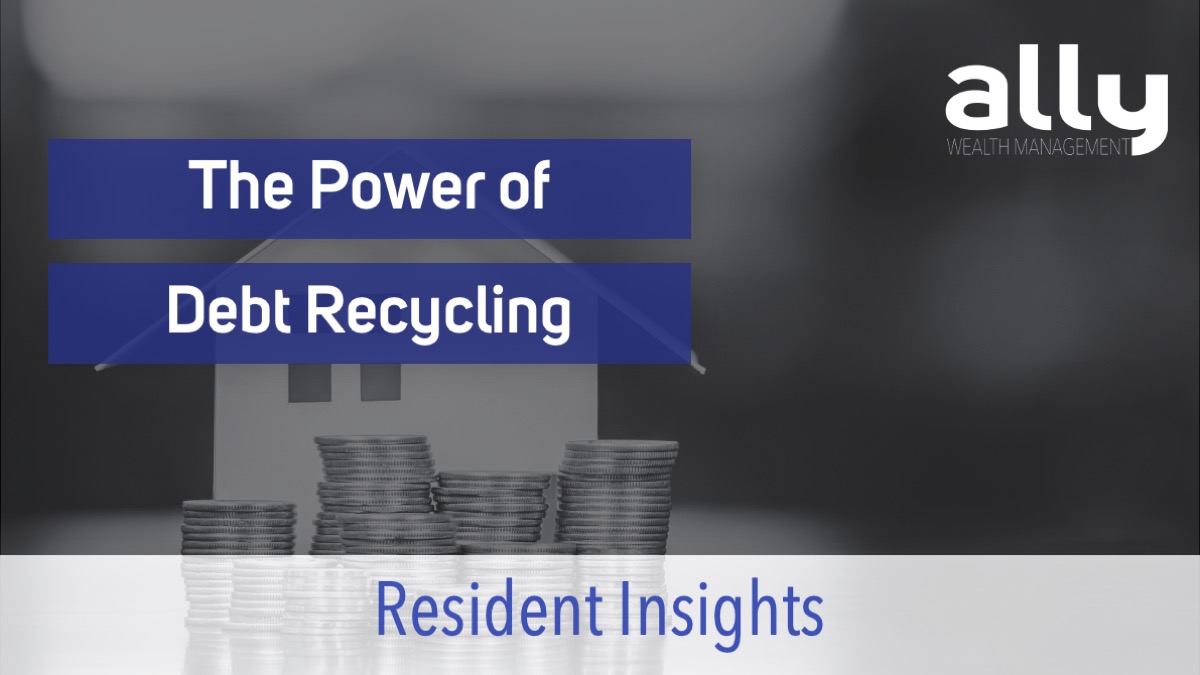The Power of Debt Recycling
If you’re a homeowner in Australia, you may be familiar with the idea of paying down your mortgage as fast as possible to become debt-free. But what if there was a way to turn that mortgage into an engine for wealth creation while still working toward paying it off? This is where the strategy of debt recycling comes into play—a financial strategy that helps you pay down your home loan, reduce your tax and allows you to invest and grow your wealth.
In this blog, we’ll break down what debt recycling is, how it works, and why it might be the strategy that helps you build long-term financial success.
What is Debt Recycling?
At its core, debt recycling is a strategy that transforms your non-deductible debt (such as your home loan) into deductible investment debt. In other words, it allows you to convert your home mortgage—a debt for which you can’t claim tax deductions—into an investment loan that gives you potential tax benefits. The beauty of this strategy lies in its ability to help you both reduce your mortgage and grow your investment portfolio at the same time.
Let’s put it simply: Normally, the interest on your home loan is something you just have to deal with—there’s no tax relief. However, if you were to take out a loan for investments (say, to buy shares or investment property), the interest on that loan would typically be tax-deductible because the money is used for an income-producing purpose.
Debt recycling combines these two concepts: you pay down your mortgage, then borrow against the repaid portion to invest in income-generating assets, potentially saving on taxes and building wealth simultaneously.
How Does Debt Recycling Work?
Debt recycling is a multi-step process that requires discipline and financial planning, but it can pay off in the long run. Here’s how it typically works:
- Start by paying down your mortgage: You begin by making extra repayments on your home loan. These repayments reduce your non-deductible debt. This step is crucial because it gives you equity in your home that you can later borrow against.
- Borrow against your home equity: Once you’ve built up some equity in your home through additional repayments, you can take out an investment loan using that equity. This borrowed amount is now deductible debt because it’s being used for investment purposes, such as purchasing shares or another income-producing asset.
- Invest the borrowed money: The next step is to invest the money you’ve borrowed into assets that generate income, like shares, managed funds, or investment property. Over time, the returns from these investments can help pay down your original home loan faster, while also generating additional wealth.
- Claim tax deductions on the investment loan interest: Since you’re using the borrowed money for investments, the interest you pay on this loan is tax-deductible. This reduces your taxable income, potentially giving you a refund at tax time that can be further used to pay down your mortgage.
- Repeat the process: Over time, as you continue to pay down your home loan, you build more equity that can be recycled into further investments. This cycle can continue until your mortgage is fully paid off, and you’re left with a portfolio of income-generating investments.
Example of Debt Recycling in Action
Let’s say you have a $500,000 mortgage, and you manage to pay down $50,000 through extra repayments. You now have $50,000 in home equity. With a debt recycling strategy, you could borrow that $50,000 back from the bank and invest it in shares or property.
Now, the interest on that $50,000 is tax-deductible because it’s being used for an investment. The income generated from your investment—whether it’s rental income or dividends from shares—can help you make additional payments toward your mortgage, speeding up the repayment process.
At the same time, because your investment loan interest is deductible, you might see a lower tax bill, giving you more money to put toward your mortgage or future investments. Over time, your investments grow, and your mortgage shrinks.
Benefits of Debt Recycling
Debt recycling offers several benefits, but the two most prominent are tax efficiency and potential wealth creation.
Tax Deductibility
One of the key advantages of debt recycling is the ability to claim tax deductions on the interest from your investment loan. Normally, the interest on your home mortgage is not tax-deductible, which means you’re paying it off with after-tax dollars. However, by converting part of your home loan into an investment loan, you turn non-deductible debt into deductible debt, which can significantly reduce your taxable income.
For example, if your home loan has an interest rate of 6%, you’re paying that with after-tax dollars. In contrast, if you take out an investment loan with the same interest rate, the interest becomes deductible, meaning you can claim it against your taxable income. This reduces your tax bill and gives you more money to either pay down your mortgage or reinvest.
Potential for Wealth Creation
Another major benefit of debt recycling is the opportunity to grow your wealth while you’re still paying off your home loan. Instead of solely focusing on reducing your mortgage, debt recycling allows you to invest in income-generating assets like shares or property. Over time, these investments can provide capital growth and generate income through dividends or rent. This not only helps to pay down your mortgage but also builds a portfolio of assets that can provide financial security in retirement.
For instance, let’s say you invest in shares with the $50,000 you borrowed against your home. Over the next 10 years, those shares may appreciate in value, and you could earn dividends each year. You could then use the dividends to make extra mortgage repayments or even reinvest them to continue growing your portfolio. By the time your mortgage is paid off, you’ve also built a sizable investment portfolio.
Factors to Consider Before Starting
Before jumping into debt recycling, there are a few key considerations you need to keep in mind to determine if this strategy aligns with your personal financial goals.
- Your Risk Tolerance
Debt recycling involves borrowing money to invest, which introduces investment risk. If the value of your investments declines, you’re still responsible for paying off both your mortgage and the investment loan. If you have a low tolerance for risk, debt recycling might not be the best strategy for you. You need to be comfortable with the ups and downs of the investment market and be prepared for the possibility of losses.
- Your Financial Discipline
Debt recycling requires a long-term commitment and discipline to stick to your financial plan. It can be tempting to use the extra money from your investments or tax savings on non-essential spending, but this will reduce the effectiveness of the strategy. If you’re committed to paying down your home loan and growing your investments, debt recycling can work well. However, if you’re not careful, you could end up with higher debt without the expected returns.
- Stable Income
Since you’ll be taking on both your existing home loan and an investment loan, it’s essential to have a stable and reliable income. If your cash flow fluctuates or you’re in an uncertain employment situation, debt recycling could put undue stress on your finances. Having a stable income ensures you can manage the repayments on both loans comfortably, even during market downturns or periods of higher interest rates.
- Investment Knowledge
Debt recycling works best when you have a sound understanding of the investments you’re making. Whether you’re investing in shares, managed funds, or property, it’s important to know the risks, expected returns, and the tax implications. If you’re new to investing, seeking advice from a financial adviser is essential to ensure that your investment decisions align with your risk profile and financial objectives.
Common Misconceptions About Debt Recycling
Despite the advantages debt recycling offers, there are a few misconceptions that can cause confusion. Let’s clear up a couple of common myths.
Misconception 1: Debt Recycling is Just Refinancing
While debt recycling and refinancing may sound similar, they’re quite different. Refinancing involves switching to a new home loan, often to secure a lower interest rate or better loan terms. It’s essentially restructuring your mortgage. Debt recycling, on the other hand, involves borrowing against the equity in your home and using the borrowed funds to invest, thereby converting non-deductible home loan debt into tax-deductible investment debt. The focus in debt recycling is on wealth creation, whereas refinancing is primarily about optimizing your existing mortgage.
Misconception 2: Debt Recycling is Only for Property Investors
Another common myth is that debt recycling is only useful if you plan to invest in property. While property is a popular investment option in Australia, debt recycling works with other income-producing assets as well, such as shares or managed funds. In fact, shares are often a preferred choice for debt recycling because they are more liquid (easier to buy and sell) than property, and dividends can provide a regular income stream.
Risks of Debt Recycling
Like any financial strategy, debt recycling comes with risks, and it’s important to weigh these carefully before diving in.
Investment Risk
One of the most significant risks in debt recycling is the possibility that your investments could decrease in value. If the assets you purchase with your investment loan perform poorly, you could end up in a situation where you have both a mortgage and an investment loan to repay, with little or no return from your investments.
For example, let’s say you borrow $50,000 to invest in shares, but due to a market downturn, the value of those shares falls to $35,000. You’re still responsible for repaying the $50,000 loan, even though your investment has decreased in value. This is why it’s critical to have a long-term view and be prepared for fluctuations in the market.
Interest Rate Risk
Debt recycling is also sensitive to changes in interest rates. If interest rates rise, the cost of both your home loan and your investment loan will increase. This could put a strain on your cash flow, especially if you’re relying on the returns from your investments to make extra payments on your mortgage. It’s important to factor in the potential for rate increases and ensure you can comfortably manage your loan repayments even in a higher interest rate environment.
Requires Long-Term Commitment
Debt recycling is not a short-term strategy. It takes time for the benefits of tax deductions and investment growth to outweigh the costs. If you’re expecting immediate returns or are planning to sell your home or exit the market in the near future, debt recycling may not be the best option for you. This strategy works best for people with a long-term investment horizon who are willing to ride out short-term market volatility.
Getting Started with Debt Recycling
If you’ve assessed your financial situation and decided that debt recycling is a good fit for you, here’s how you can get started:
- Consult with a Financial Adviser
Debt recycling can be complex, so it’s important to seek professional advice. A financial adviser can help you determine whether it’s the right strategy for your circumstances and guide you through the process, ensuring that your investment choices align with your financial goals.
- Review Your Mortgage and Equity
Take a close look at your current mortgage balance and the equity you’ve built up in your home. This will give you a clearer idea of how much you can potentially borrow to invest.
- Create a Plan
Once you’ve consulted with your financial adviser, work together to create a clear debt recycling plan. This should include how much extra you’ll pay into your mortgage, how much you’ll borrow for investments, and what type of assets you’ll invest in. Your plan should also outline how you’ll manage your loan repayments and ensure you can maintain a healthy cash flow.
- Start Investing
With a plan in place, you can begin making extra payments on your mortgage and borrowing against your home equity to invest. Over time, monitor the performance of your investments and adjust your strategy as needed to stay on track.
Conclusion
Debt recycling can be a powerful financial strategy that allows you to turn your mortgage into a tool for wealth creation while still working toward becoming debt-free. By converting non-deductible home loan debt into tax-deductible investment debt, you can reduce your tax burden and grow your wealth through smart investments.
However, like any strategy, debt recycling comes with risks, and it’s not suitable for everyone. It requires financial discipline, a stable income, and a long-term commitment to see the benefits. Before embarking on debt recycling, make sure to consult with a financial adviser to determine whether it aligns with your goals and risk tolerance.
If you’re ready to take control of your financial future, debt recycling could be the key to turning your mortgage into a powerful wealth-building tool. Reach out to your financial adviser today to see if this strategy is right for you.
Ally Wealth Management is the trusted ally in finance for Australians at home and across the globe. As both Australian expats and residents, the founders of Ally have a unique understanding of the common personal financial challenges faced.
Book your complimentary appointment with our team at Ally Wealth Management to discuss how we can help you to achieve your financial goals.
Ally Wealth Management Pty Ltd is a Corporate Authorised Representative of Sentry Advice Pty Ltd ABN 77 103 642 888. Sentry Advice holds an Australian Financial Services Licence (AFSL) No. 227 748.
General Advice Warning: The information contained herein is of a general nature only and does not constitute personal advice. You should not act on any recommendation without considering your personal needs, circumstances, and objectives. We recommend you obtain professional financial advice specific to your circumstances.




